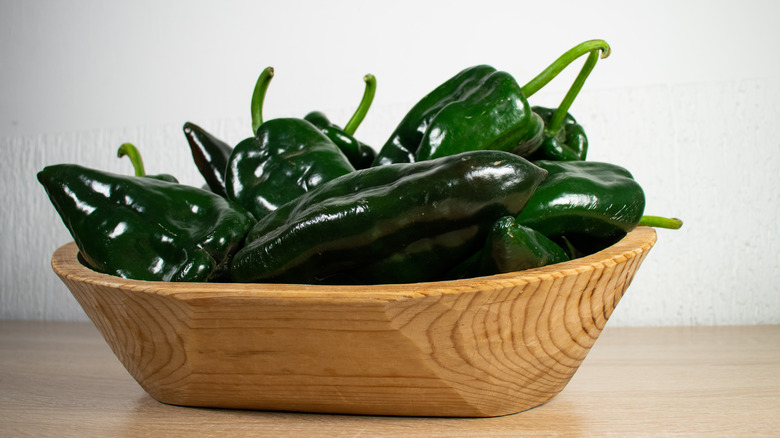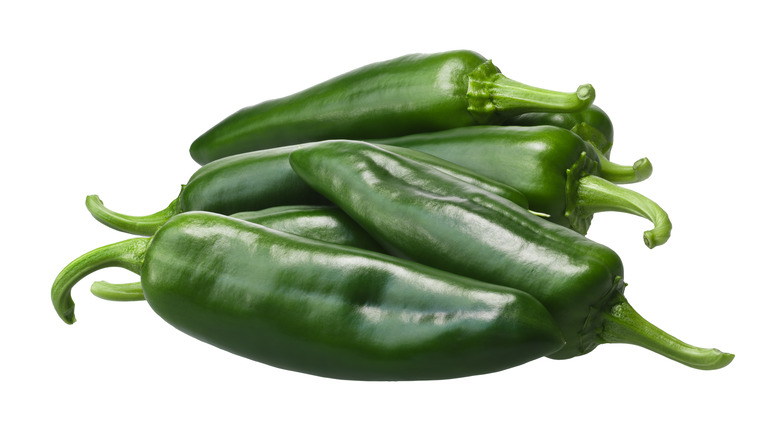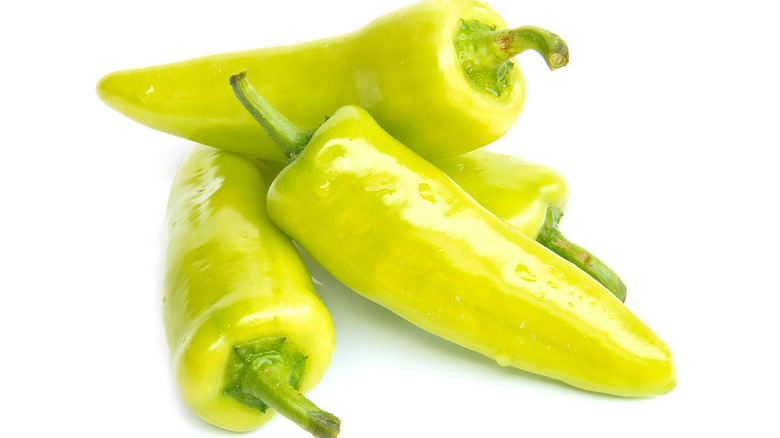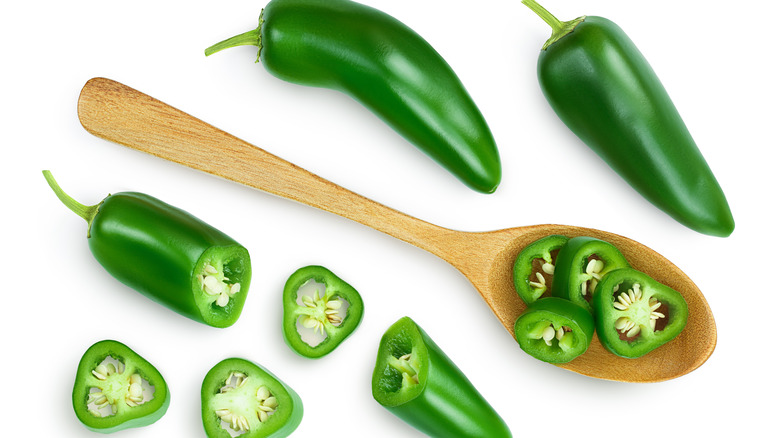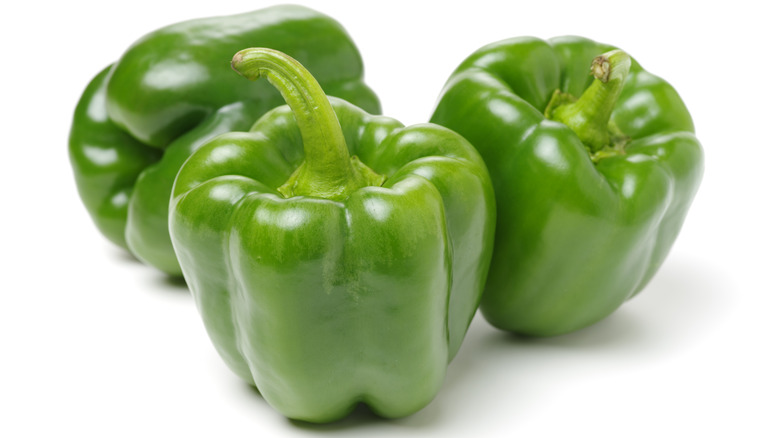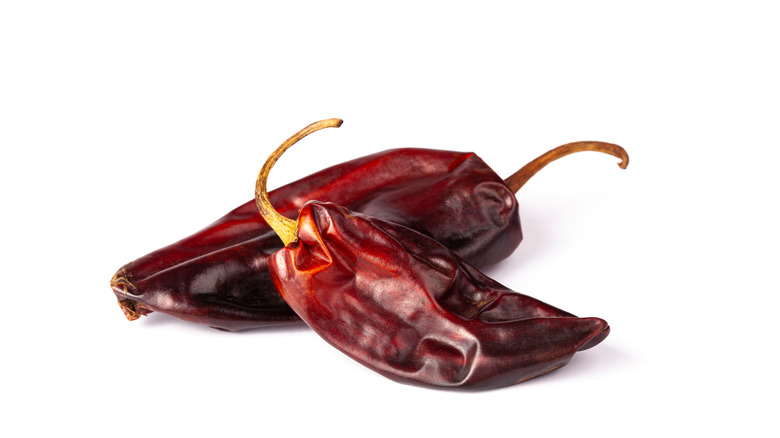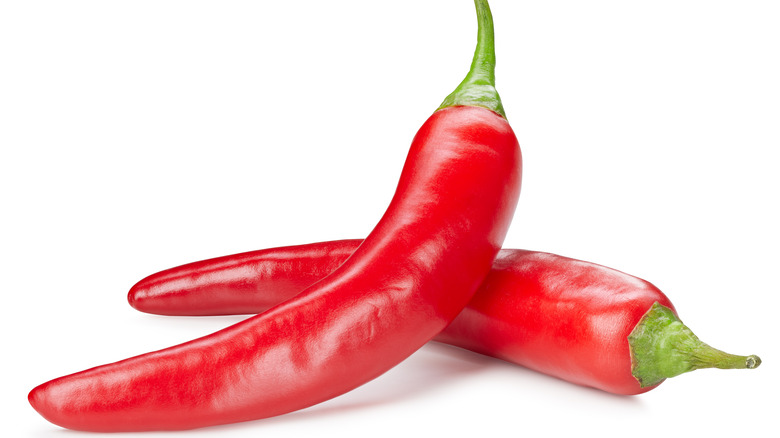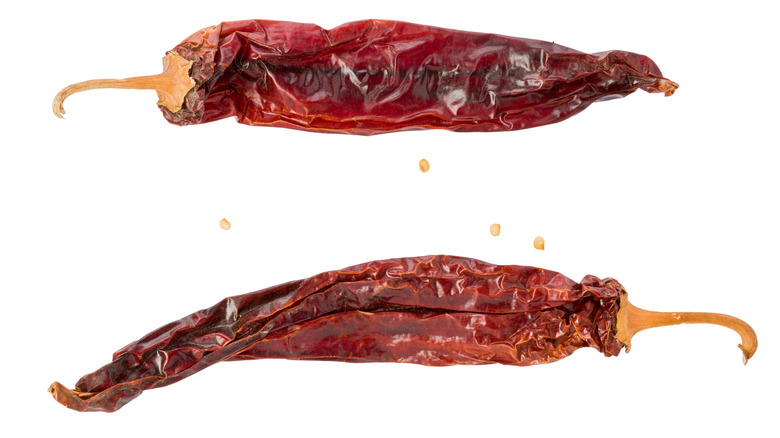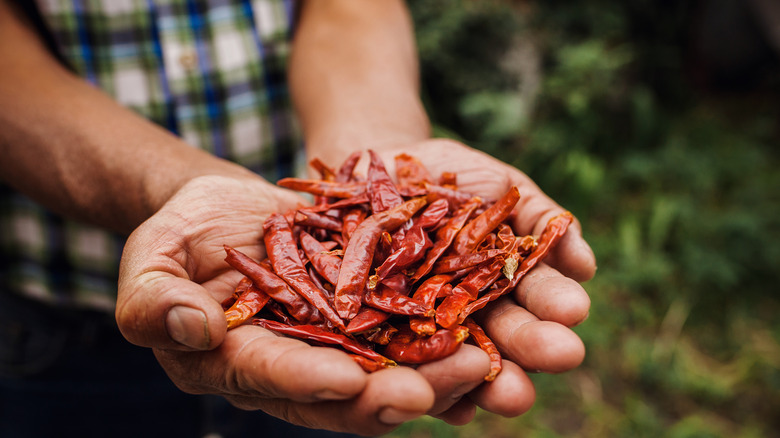8 Best Substitutes For Poblano Peppers
Are you looking for new ways to spice up your home-cooked meals? Get yourself familiar with poblano peppers. Originating in Puebla, Mexico, according to Taste Atlas, poblano peppers have gained worldwide recognition due to the increasing popularity of Mexican cuisine. This large and luscious dark green, almost black, chile is known for its earthy and full-bodied flavor, and its mildly spicy taste (via Markerland Foodie). Due to its low levels of spice and sweetness, this beloved pepper can either be roasted and eaten whole or stuffed with meat and vegetables to provide your dish with just the right amount of kick.
But, picture this. You walk into your kitchen, all ready to prepare a comforting dish of poblano peppers stuffed with chicken and cheese, when you realize that you are missing your star ingredient. Before you rush all the way back to the grocery store, hold your horses. Lucky for you, the spicy pepper family is relatively large, and you may already have a suitable substitution hiding in your refrigerator.
1. Anaheim Peppers
If you're looking for a top-notch poblano pepper substitute, here's your guy. With a similar appearance and shape, Anaheim peppers can be used in a nearly identical fashion to poblanos. Although this hot pepper originates from New Mexico, it gets its name from Anaheim, California. An Anaheim pepper has thick walls that are perfect for supporting a stuffed pepper dish, and it also shares a similar width to its spicy sister. That being said, Anaheim peppers make the best substitutes when they are being chopped, sliced, or diced and added to a salad, soup, or stew. If you don't have any Anaheim peppers lurking around, check your pantry. This versatile chile also comes in a powdered form (per Gourmet Sleuth).
The key difference between Anaheim and poblano peppers comes down to the flavor. You will want to bear in mind that Anaheim peppers are slightly more spicy than poblanos, and can even ratchet up to double the amount of spice, depending on the one you pick out (via Recipe Marker). Additionally, Anaheim peppers have a slightly sweeter flavor profile. You may want to be conservative and pull back on the amount of Anaheim peppers you substitute in your dish to start with, to avoid affecting the flavor too drastically — and then add to taste.
2. Cubanelle Peppers
If you're not a huge fan of spice, then Cubanelle peppers may be the perfect poblano understudy that you're looking for. Similar in size to the Anaheim, this pepper is known for its quick cooking qualities. So, when you're in a rush to put dinner on the table, Cubanelles can be your new best friends.
Keep in mind, there are a few differences that set Cubanelle and poblano peppers apart. Cubanelle peppers are up to ten times as mild as poblanos. Think of bell peppers, with a pinch more zest. Cubanelles also have a sweet flavor profile, and are therefore not encouraged for recipes that call for chopped or diced peppers. Also good to note — the walls are not as thick on this pepper variety. While they still can make a suitable substitute for a stuffed pepper dish, use a little caution cooking with them (via The Kitchen Community).
3. Jalapeño Peppers
Looking for a substitute that really packs a punch? Try the tiny but mighty jalapeño pepper. But, don't be fooled by appearances — although jalapeños may look like chili peppers, they are still great to use in stuffing recipes. Bear in mind that jalapeños are a far smaller pepper whereas poblanos look more like the bigger bell pepper variety.
Perfect for salads, salsas, or sauces (try saying that five times fast), when it comes to bringing the heat, poblanos are no match for the spicy hot jalapeño, so if you're looking for more heat, this is a great swap. If you are looking to lessen the heat in your dish, however, consider taking out the ribs and pits of the jalapeños before incorporating them in your dish (via Markerland Foodie).
4. Bell Peppers
In terms of what you might already have lying around to substitute poblanos, bell peppers are a pretty sure bet. Bell peppers are very similar in size and appearance to poblanos. With their thick walls and huge cavities, this type is the perfect backup for a stuffed pepper recipe. If you have a fridge full of bells, opt for the green variety. Green bell peppers have a richer and more savory flavor, while the yellow, red, and orange bells tend towards the sweeter side (per The Kitchen Community).
But, let's address the elephant in the room. When it comes to spice, poblano and bell peppers are distant relatives, at best. Bell peppers are far more mild, and some would say they are completely lacking in the spice department. If flavor is particularly important to your dish, mixing in a bit of chili powder or other powdered spices would be a great way to amp up the heat levels just a tad, rather than using bell peppers on their own.
5. Guajillo Peppers
Similar to poblano peppers, Guajillo peppers are very unique to Mexican cuisine, and have also increased in popularity over the years. Defined by their smooth, dark red skin and rich flavor, these peppers are best suited for sauces and salsas. With their deeply vibrant taste, they will take any baked dish or stir fry to the next level (via Substitute Cooking). Unlike many other peppers on this list, Guajillo peppers are most commonly found in dry, powdered, or paste form. So, be sure to check your cupboards for these Guajillo varieties if you are in a bind!
For reference, the heat levels of Guajillo peppers are on par with jalapeños, so these peppers are far spicier than poblanos. You might want substitute less than what the recipe calls for to start with, unless you can take the heat (via Markerland Foodie).
6. Cayenne Peppers
Next up are cayenne peppers. Originating in Central and South America, these spicy peppers are unfortunately too long and thin to be used in stuffed recipes. However, their delicious, spicy flavoring is pretty on par with poblanos, which makes them an excellent flavor substitute. You might be familiar with cayenne, the spice, and most likely have it hanging around on your spice rack already. That's because cayenne peppers are ordinarily used dry or as a powder to add a certain kick to a dish.
Interestingly, cayenne peppers also are claimed to have some health benefits, including possibly assisting with digestion, alleviating pain, reducing hunger, and speeding up metabolism (via Conscious Eating). So, it might be worth incorporating these peppers in more of your home recipes.
The best part about this backup ingredient is that the mental math is super easy when substituting. Depending on how much poblano your recipe calls for, keep the ratio at one cayenne pepper for every one poblano pepper and you'll be good to go (via The Kitchen Community).
7. New Mexico Chiles
Another amazing alternative to poblano peppers are New Mexico chiles. These hot peppers are known for their sweet, earthy, and grassy flavor, with a medium amount of spice similar to that of the poblano. If you've selected this substitute for your dish, you don't have to worry about these peppers adding too much heat, but expect and mentally prepare for a different flavor profile, says Substitute Cooking.
Most commonly used in red sauces, this pepper is perfect for baked goods, soups, stews, sauces, and stir fries. Fun fact: Green New Mexico chiles make a mean substitute for garlic and onions, says Gourmet Sleuth, as they share a similar crunchy and crispy texture.
New Mexico chiles are typically cooked for approximately 5-10 minutes in a frying pan before they are added to a dish, but they can also be added straight to your recipe once ready (via Conscious Eating).
8. Ancho Chiles
Last but not least, Ancho chiles make great poblano pepper substitutes. This sweet and spicy pepper is simply a dried poblano, and is a great alternate for when a recipe calls for diced poblano peppers. Despite the connection between these two peppers, however, Ancho chilies and poblano peppers vastly differ when it comes to their flavor profile. Because Ancho chilies are dried, they have a smokier and grassier flavor than a fresh pepper substitute. Additionally, Ancho chilies are far more mild when it comes to heat (via Recipe Marker).
When using this substitute, reign in the amount of Ancho chilies you throw into your dish. Don't add too many peppers to your recipe to start — because of the difference in flavor between these two ingredients, you will want to taste test, and adjust accordingly. The most important part about using this back-up ingredient is that it must be rehydrated prior to cooking with it.
